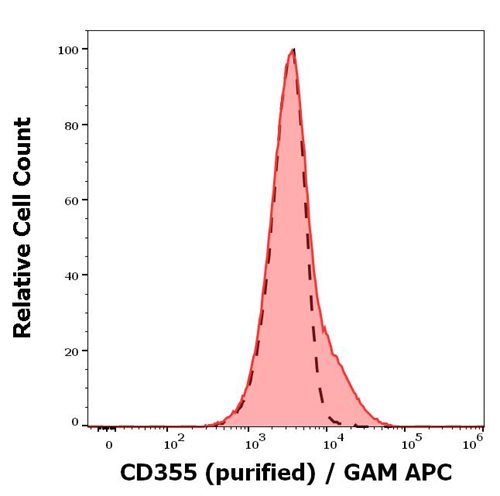Anti-CD11a / LFA-1 alpha chain Monoclonal Antibody (Clone:MEM-25)-PE Conjugated

Figure 1: Surface staining of human peripheral blood cells with anti-human CD11a (MEM-25) PE.
Roll over image to zoom in
Shipping Info:
For estimated delivery dates, please contact us at [email protected]
| Amount : | 100 tests |
| Isotype : | Mouse IgG1 |
| Storage condition : | Store in the dark at 2-8°C. Do not freeze. Avoid prolonged exposure to light. |
CD11a (LFA-1 alpha) together with CD18 constitute leukocyte function-associated antigen 1 (LFA-1), the alphaLbeta2 integrin. CD11a is implicated in activation of LFA-1 complex. LFA-1 is expressed on the plasma membrane of leukocytes in a low-affinity conformation. Cell stimulation by chemokines or other signals leads to induction the high-affinity conformation, which supports tight binding of LFA-1 to its ligands, the intercellular adhesion molecules ICAM-1, -2, -3. LFA-1 is thus involved in interaction of various immune cells and in their tissue-specific settlement, but participates also in control of cell differentiation and proliferation and of T-cell effector functions. Blocking of LFA-1 function by specific antibodies or small molecules has become an important therapeutic approach in treatment of multiple inflammatory diseases. For example, humanized anti-LFA-1 antibody Efalizumab (Raptiva) is being used to interfere with T cell migration to sites of inflammation; binding of cholesterol-lowering drug simvastatin to CD11a allosteric site leads to immunomodulation and increase in lymphocytic cholinergic activity.
| Subcellular location: | Cell membrane |
| Post transnational modification: | In resting T-cells, up to 40% of surface ITGAL is constitutively phosphorylated. Phosphorylation causes conformational changes needed for ligand binding and is necessary for activation by some physiological agents. |
| Tissue Specificity: | Leukocytes. |
| BioGrid: | 109889. 6 interactions. |
|
There are currently no product reviews
|












.png)










